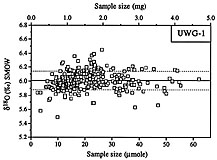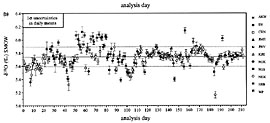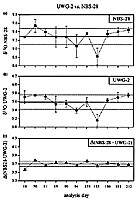UWG-2, A Garnet Standard for Oxygen Isotope Ratios: Strategies for High Precision and Accuracy with Laser Heating
Valley, John W., Kitchen, Nami, Kohn, Matthew J., Niendorf, Christopher R., and Spicizza, Michael J. (1995) UWG-2, a garnet standard for oxygen isotope ratios: Strategies for high precision and accuracy with laser heating. Geochimica et Cosmochimica Acta, v. 59, n. 24, p. 5223-5231.
Abstract
UWG-2 is a new garnet standard for oxygen isotope analysis prepared from a single large porphyroblast that was homogeneous (±0.21‰) at the millimeter-scale before grinding. The d18O value of UWG-2 has been determined in seven laboratories using either a laser probe system or externally heated Ni reaction vessels. The raw laser probe value is 5.74‰ at the University of Wisconsin. If all data are normalized to NBS-28 = 9.59‰, then the UW value (5.89‰) is in good agreement with the average of all labs (5.78‰). There is no significant difference between garnet analyses made with the two techniques, nor among labs using different wavelengths of IR laser. UWG-2 is available for interlaboratory comparison, and for assessing the performance of microanalytical techniques including laser probes and ion microprobes with a recommended value of d18O = 5.8‰ SMOW.
Multiple, daily analyses of UWG-2 at the University of Wisconsin provide an accurate evaluation of all components in our laser-probe, mass-spectrometer system, and allow analytical problems to be rapidly identified. With this standardization, the accuracy of a single laser probe analysis is better than ±0.10‰. Over 1000 analyses of UWG-2 have been made. The average of all uncorrected d18O values is 5.74 ± 0.15‰ (1 sd). The precision on a single day averages ±0.07‰ and is frequently better than 0.05‰. The uncertainty in the mean for all analyses is ±0.005‰ (1s ). A small drift of the daily average over time results from inevitable changes in the vacuum line which require careful attention and maintenance.
| Figure
3. Uncorrected analyses of UWG-1 as a function of sample size.
There is no difference with sample size from 0.5 mg to over 4 mg. |
 |

